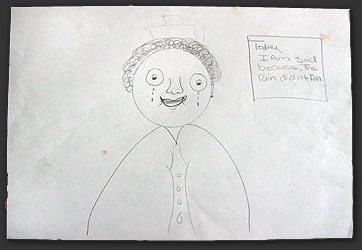 This case illustrates an excellent use of art therapy. This 13 year old girl began therapy with a complicated symptom pattern resulting from years of childhood sexual abuse. She had gone so long without treatment that her affect was very irregular. She would sit on the couch week after week, insisting that nothing was bothering her, or she would talk desperately about how her life was never going to get better. She was unwilling to try art therapy and was generally skeptical about the whole treatment process. This case illustrates an excellent use of art therapy. This 13 year old girl began therapy with a complicated symptom pattern resulting from years of childhood sexual abuse. She had gone so long without treatment that her affect was very irregular. She would sit on the couch week after week, insisting that nothing was bothering her, or she would talk desperately about how her life was never going to get better. She was unwilling to try art therapy and was generally skeptical about the whole treatment process.
 What I noticed was that her facial expressions never seemed to match what she talked about feeling. For example, she would insist that she was feeling happy when she was clearly holding back tears, or she would smile and giggle while she talked about being in a tremendous amount of pain. When I tried to point out to her what I was noticing, on several occasions, she didn’t understand. What I noticed was that her facial expressions never seemed to match what she talked about feeling. For example, she would insist that she was feeling happy when she was clearly holding back tears, or she would smile and giggle while she talked about being in a tremendous amount of pain. When I tried to point out to her what I was noticing, on several occasions, she didn’t understand.
 When she was finally ready to draw her first picture, I asked her to draw anything she wanted. She drew herself crying and smiling at the same time, writing on the picture that she was sad. We looked at the picture together for a long time. When she was finally ready to draw her first picture, I asked her to draw anything she wanted. She drew herself crying and smiling at the same time, writing on the picture that she was sad. We looked at the picture together for a long time.
|
|
 I was able to explain to her that this was what I had been seeing for the many weeks that I had been looking at her while she sat on the couch and talked. Now she was able to actually look at it herself. The art became a mirror that explained something that my words had not been able to. This was her first major breakthrough in therapy. I was able to explain to her that this was what I had been seeing for the many weeks that I had been looking at her while she sat on the couch and talked. Now she was able to actually look at it herself. The art became a mirror that explained something that my words had not been able to. This was her first major breakthrough in therapy.
 You can see from a later picture (several weeks and many pictures later,) that she began to make connections between facial expressions and an appropriate symbol to match the expression and emotion. We are currently working on developing her vocabulary to name those feelings and emotions, which she does not yet have. This is clear from the cartoon bubble with the blank lines. You can see from a later picture (several weeks and many pictures later,) that she began to make connections between facial expressions and an appropriate symbol to match the expression and emotion. We are currently working on developing her vocabulary to name those feelings and emotions, which she does not yet have. This is clear from the cartoon bubble with the blank lines.
 With more art therapy and the use of some creative tools, this patient’s prognosis of gaining the vocabulary she needs to progress to incorporating verbal psychotherapy into her treatment and “filling in those blank lines” is excellent. Art therapy started this process. With more art therapy and the use of some creative tools, this patient’s prognosis of gaining the vocabulary she needs to progress to incorporating verbal psychotherapy into her treatment and “filling in those blank lines” is excellent. Art therapy started this process.
back « |
|
|

